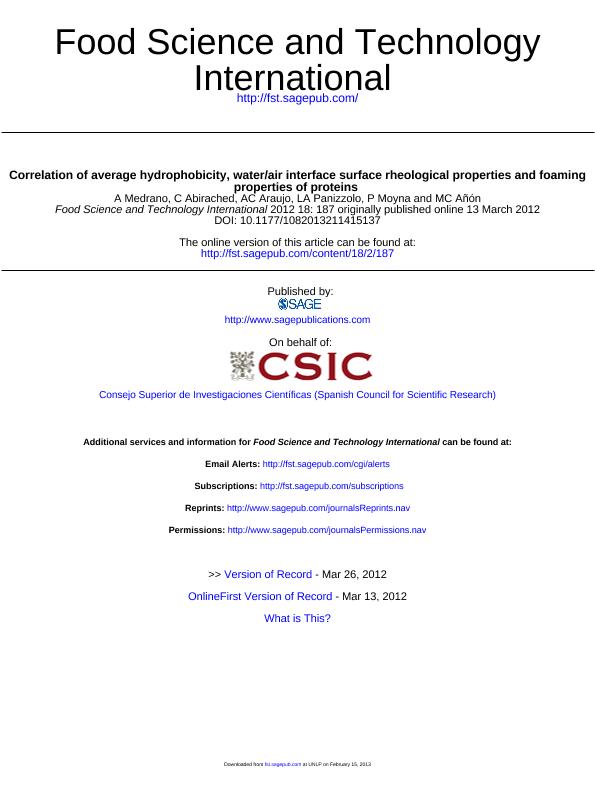Mostrar el registro sencillo del ítem
dc.contributor.author
Medrano, A.
dc.contributor.author
Abirached, C.
dc.contributor.author
Araujo, A. C.
dc.contributor.author
Panizzolo, L. A.
dc.contributor.author
Moyna, P.
dc.contributor.author
Añon, Maria Cristina

dc.date.available
2016-12-29T14:09:13Z
dc.date.issued
2012-03-13
dc.identifier.citation
Medrano, A.; Abirached, C.; Araujo, A. C.; Panizzolo, L. A.; Moyna, P.; et al.; Correlation of average hydrophobicity, water/air interface surface rheological properties and foaming properties of proteins; Sage Publications Ltd; Food Science and Technology International; 18; 2; 13-3-2012; 187-193
dc.identifier.issn
1082-0132
dc.identifier.uri
http://hdl.handle.net/11336/10581
dc.description.abstract
A comparative study on the behavior in the air–water interface of b-lactoglobulin, a-lactoalbumin, glycinin and b-conglycinin was performed. The behavior at the interface was evaluated by equilibrium surface tension and surface rheological properties of adsorbed films. There were significant differences (a 0.05) in the values of the constants of adsorption to the interface of the four proteins. The glycinin had the slowest rate of adsorption, due to its low average hydrophobicity, low molecular flexibility and large molecular size. Smaller proteins like b-lactoglobulin and a-lactoalbumin tended to greater equilibrium pressure values than the larger proteins because of its higher rate of adsorption to the interface. The foam capacity of proteins showed a positive correlation with the average hydrophobicity; the maximal retained liquid volume or the initial rate of passage of liquid to foam were significantly lower (a 0.05) when protein was glycinin. The dilatational modulus of glycinin was the lowest, which implies lowest resistance to disruption of the film. Glycinin protein has lower proportion of gravitational drainage and higher disproportionation having perhaps a less resistant film. In conclusion, b-conglycinin and whey proteins showed a similar behavior, so b-conglycinin might be the best soybean protein to replace milk proteins in food formulations.
dc.format
application/pdf
dc.language.iso
eng
dc.publisher
Sage Publications Ltd

dc.rights
info:eu-repo/semantics/openAccess
dc.rights.uri
https://creativecommons.org/licenses/by-nc-nd/2.5/ar/
dc.subject
Soy Proteins
dc.subject
Milk Whey Proteins
dc.subject
Interfacial Rheology
dc.subject
Foams
dc.subject.classification
Alimentos y Bebidas

dc.subject.classification
Otras Ingenierías y Tecnologías

dc.subject.classification
INGENIERÍAS Y TECNOLOGÍAS

dc.title
Correlation of average hydrophobicity, water/air interface surface rheological properties and foaming properties of proteins
dc.type
info:eu-repo/semantics/article
dc.type
info:ar-repo/semantics/artículo
dc.type
info:eu-repo/semantics/publishedVersion
dc.date.updated
2016-12-12T14:10:12Z
dc.identifier.eissn
1532-1738
dc.journal.volume
18
dc.journal.number
2
dc.journal.pagination
187-193
dc.journal.pais
Reino Unido

dc.journal.ciudad
Londres
dc.description.fil
Fil: Medrano, A.. Universidad de la Republica; Uruguay
dc.description.fil
Fil: Abirached, C.. Universidad de la Republica; Uruguay
dc.description.fil
Fil: Araujo, A. C.. Universidad de la Republica; Uruguay
dc.description.fil
Fil: Panizzolo, L. A.. Universidad de la Republica; Uruguay
dc.description.fil
Fil: Moyna, P.. Universidad de la Republica; Uruguay
dc.description.fil
Fil: Añon, Maria Cristina. Consejo Nacional de Investigaciones Científicas y Técnicas. Centro Científico Tecnológico la Plata. Centro de Investigaciones en Criotecnología de Alimentos (i); Argentina. Universidad Nacional de La Plata; Argentina
dc.journal.title
Food Science and Technology International

dc.relation.alternativeid
info:eu-repo/semantics/altIdentifier/doi/http://dx.doi.org/10.1177/1082013211415137
dc.relation.alternativeid
info:eu-repo/semantics/altIdentifier/url/https://journals.sagepub.com/doi/10.1177/1082013211415137
Archivos asociados
